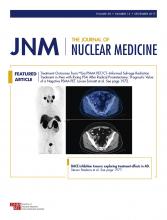TO THE EDITOR: We read with interest the article by Ohira et al. (1). The authors investigated inter- and intraobserver agreement in 18F-FDG PET/CT interpretation for patients with suspected cardiac sarcoidosis. Their retrospective study included patients from August 2009 to April 2014, who were divided into two groups that had different pretest preparation protocols aimed at suppressing background myocardial 18F-FDG uptake. We would like to highlight a few study limitations that warrant the authors’ consideration.
Their first 46 18F-FDG PET/CT scans, performed between August 2009 and June 2012, had a pretest preparation protocol consisting of at least a 12-h fast and a heparin injection (no-restriction protocol), whereas their next 54 scans, performed between July 2012 and April 2014, had the additional preparation of a low-carbohydrate, high-fat, protein-permitted diet before the 12-h fast (low-carb protocol). This description suggests that the authors were not satisfied with the outcome of the no-restriction protocol, yet there was no description of the duration of the low-carb diet, nor was it indicated whether noncompliant patients were identified and excluded or whether the low-carb protocol better suppressed background uptake than the no-restriction protocol. Surprisingly, even though there were 19 patients who underwent more than one scan (a total of 46 scans, with a range of 2–4 and a median of 2 scans each; 15 patients had repeated scans to assess response to therapy, and 4 patients had repeated scans to clarify diagnosis), there were no images or discussions of whether the repeated scans had the same preparation protocol or of how any discrepancies between the initial and repeated scans were interpreted.
The authors categorized cardiac 18F-FDG uptake into 5 patterns: none (pattern 1), focal (pattern 2), focal on diffuse (pattern 3), diffuse (pattern 4), and isolated lateral wall or basal (pattern 5). They considered patterns 1, 4, and 5 as not consistent with active cardiac sarcoidosis since “these patterns are observed in healthy subjects (2–4).” Any patient with patterns 2 or 3 but with a myocardial SUVmax less than the liver SUVmean were considered not consistent with active cardiac sarcoidosis. Otherwise, patterns 2 and 3 were considered positive findings consistent with active cardiac sarcoidosis. The authors used the guidelines of the Japanese Ministry of Health and Welfare as the reference standard for diagnosing cardiac sarcoidosis (5). However, the authors did not comment on any correlation between the 18F-FDG PET/CT results and the results of other imaging, such as cardiac MRI and clinical findings. Furthermore, because these guidelines have not been clinically validated and do not have perfect diagnostic accuracy (6–8), was there any discrepancy between the 18F-FDG PET/CT results and other test criteria when using these guidelines? If so, how did the authors interpret the image results?
We think there were arbitrary and subjective interpretations in Figures 1 and 2 of their paper, which we assume were the best-available figures from their study. The intensity and contrast of Figures 1 and 2 were not adjusted to the same scale, as evidenced by the soft-tissue uptake on the maximum-intensity-projection PET images and myocardial uptake on the cardiac images. Such discrepancies in image processing can easily lead to the subjective interpretation of the patterns “focal on diffuse,” “isolated lateral,” and “isolated lateral and basal pattern,” as shown in Figures 1B, 2B, and 2C, respectively. For example, we believe the “isolated lateral” and “isolated lateral and basal” patterns shown in Figures 2B and 2C fit better into the authors’ “focal on diffuse” category.
In addition, we believe that the “focal on diffuse” pattern may be interpreted differently as being active cardiac sarcoidosis. First, the focal uptake in a background of diffuse uptake could represent physiologic papillary muscle uptake in the setting of failed suppression of physiologic myocardial uptake, and papillary muscle activity has the pattern of protruding inward, as shown in their Figure 1B. Second, an active hypermetabolic cardiac sarcoidosis lesion cannot be differentiated from unsuppressed background physiologic 18F-FDG avidity in the myocardium. For the same reason, the “diffuse” pattern cannot be interpreted as not consistent with active cardiac sarcoidosis. Rather, we believe the “focal on diffuse” actually is “diffuse” and should be interpreted as indeterminate for cardiac sarcoidosis (9).
The lack of optimal suppression of myocardial background 18F-FDG uptake accounts, at least in part, for the intra- and interobserver variability in the authors’ study. In our experience, even preparation with a 24-h pretest low-carb diet is inadequate to consistently suppress physiologic 18F-FDG uptake in the myocardium, and a 72-h diet preparation protocol has been shown to provide satisfying results (9). We believe that with a modified patient preparation protocol and image categorization, the authors would have achieved even greater intra- and interobserver agreement. Imaging of cardiac sarcoidosis remains challenging. Long-term prospective multicenter clinical trials are required to further validate the optimal PET imaging protocol.
Footnotes
Published online Jun. 29, 2017.
- © 2017 by the Society of Nuclear Medicine and Molecular Imaging.







